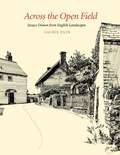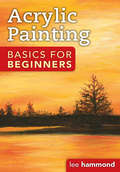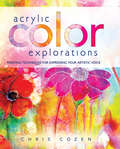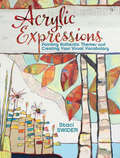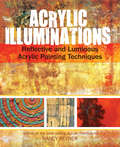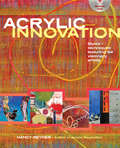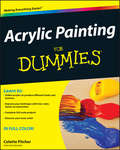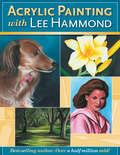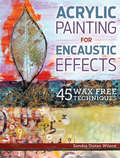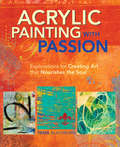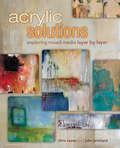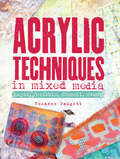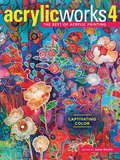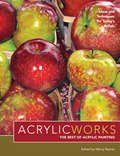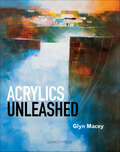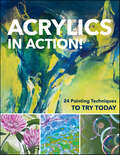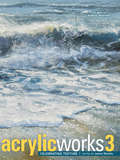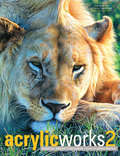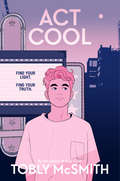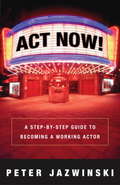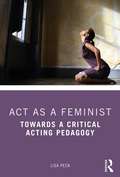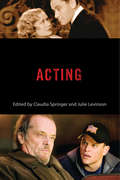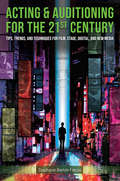- Table View
- List View
Across the Open Field
by Laurie Olin"Twenty-eight years ago I went to England for a three-month visit and rest. What I found changed my life."So begins this memoir by one of America's best-known landscape architects, Laurie Olin. Raised in a frontier town in Alaska, trained in Seattle and New York, Olin found himself dissatisfied with his job as an urban architect and accepted an invitation to England to take a respite from work. What he found, in abundance, was the serendipity of a human environment built over time to respond to the land's own character and to the people who lived and worked there. For Olin, the English countryside was a palimpsest of the most eloquent and moving sort, yet whose manifestation was of ordinary buildings meant to shelter their inhabitants and further their work.With evocative language and exquisite line drawings, the author takes us back to his introduction to the scenes of English country towns, their ancient universities, meandering waterways, and dramatic cloudscapes racing in from the Atlantic. He limns the geologic histories found within the rock, the near-forgotten histories of place-names, and the recent histories of train lines and auto routes. Comparing the growth of building in the English countryside, Olin draws some sobering conclusions about our modern lifestyle and its increasing separation from the landscape.As much a plea for saving the modern American landscape as it is a passionate exploration of what makes the English landscape so characteristically English, Across the Open Field is "an affectionate ramble through real places of lasting worth."
Acrylic Basics for Beginners
by Lee HammondLee Hammond helps you get your acrylic paintings past that initial "awkward stage" with great tips and tricks for achieving realistic results.
Acrylic Color Explorations: Painting Techniques for Expressing Your Artistic Voice
by Chris CozenDiscover your true color voice!Acrylic Color Explorations will have you seeing the world around you in a new way as color theory becomes engaging, easy-to-understand and fun. Not only will you achieve a basic understanding of color and pigments, but author Chris Cozen will also guide you through a personal exploration of color in 30 exercises using acrylic paint.Go beyond the red-yellow-blue understanding of the color wheel by exploring the work of several artists who work with color in unique ways. Determining when to introduce a calming color or when to turn the color volume up is a skill that can be developed through practice and intention, and with Acrylic Color Explorations you will learn how to do both!Learn 33 techniques for incorporating and developing color in your paintings.Explore practical color basics with exercises and color challenges that will help you determine your color "voice."Discover secrets to mastering any creative color situation with 9 contributing artists!Embrace your true color voice today!
Acrylic Expressions: Painting Authentic Themes and Creating Your Visual Vocabulary (Acrylic Painting Studio Ser.)
by Staci SwiderCreate artwork that is a reflection of you! Your artwork is your voice, as unique as your fingerprints, and Acrylic Expressions shows you to how to paint and express your authentic self. Learn to create a consistent and individualized body of work through workshop-style instruction and creative prompts. Discover how to paint intuitively by uncovering meaningful personal symbols and distilling them into a visual vocabulary. Then combine your interpretation and personal inspiration as you use acrylic paints and other materials to create textural, expressive, abstract-style works of art. Develop a signature painting style by discovering your own unique color palette.Find the source of your inspiration--childhood memories, folklore, the natural world--and create a personal library of symbols and marks to use to build complex and layered artworks.Learn to take a common theme and apply it to a variety of compositional approaches to develop your own series of self-reflective paintings.Features 20 step-by-step projects with painting and mixed media. Build intuitive art from scratch and learn to experiment with texture, color and even how to create painting surfaces with power tools.
Acrylic Illuminations: Reflective and Luminous Acrylic Painting Techniques
by Nancy Reyner50 dazzling techniques...for work that shines above the rest! From the author of the best-selling books Acrylic Revolution and Acrylic Innovation, this book blazes new creative territory with 50 techniques that harness the artistic power of light. Ranging from subtle glazing on metal leaf, to pearly sheens, to boldly colored optical effects and glossy surfboard finishes, these approaches represent the most requested aspects of Nancy Reyner's popular workshops. 50 eye-catching techniques feature metal leaf, reflective paints, pouring, fluorescent and phosphorescent paints, refractive layering and optical color effects. Possibilities are vividly illustrated with diverse work from 44 artists. A "Crash Course on Acrylic" chapter offers an overview of how to use these versatile paints and products to their fullest potential. This hands-on guide provides clear step-by-step directions to successfully execute these new and exciting techniques. Explore matte skin construction, sheen shifting, embedding objects, patinas and polished stone effects. Use these approaches for organic, abstract or realistic styles...as backgrounds, top layers, or accents layered in between...combine, experiment, and let your paintings shine.
Acrylic Innovation: Styles and Techniques Featuring 84 Visionary Artists
by Nancy ReynerAcrylic is often used as a substitute for oil paint or watercolor, but the real gold mine is in allowing the medium freedom to do what it does best. This book shows how today's artists are doing exactly that. It's loaded with original artwork and valuable insight from 64 artists, incredibly diverse in styles and subjects, each using acrylic in unique ways to create expressive and personal art. · 64 artists offer their individual ideas, approaches and inspirations for working with acrylic paints· 29 styles, ranging from photorealism to minimal color field and everything in between, are explored through artist profiles, artwork and boundary-breaking "challenges" that provide dynamic starting points for your own art· 29 step-by-step demonstrations illustrate acrylic-driven techniques you can take straight to your work, including collage and assemblage, reverse painting, printmaking, accidental stenciling, working with metallic mixtures and moreA follow-up to the best-selling Acrylic Revolution, Acrylic Innovation takes you outside your comfort zone. Dip in whenever you feel the urge to experiment, have fun and see fresh and exciting results.
Acrylic Painting For Dummies
by Colette PitcherCreate gorgeous paintings with this fun and easy guide to acrylics! Always wanted to paint with acrylics? This easy-to-follow, full color guide gives you expert instruction and simple exercises in acrylic painting techniques and styles. The step-by-step projects let you practice your skill and stir your imagination - and give you the foundation to create similar projects with your own subjects and surfaces! Get your feet (and brushes) wet - assemble your materials, prepare your surfaces, and sort out additives and enhancers Try out basic acrylic techniques - work with brush strokes, control and thin your paint, experiment with textures, and use stencils Practice design and composition principles - mix and use color, balance elements, make changes, and pull your painting together Imitate several kinds of styles - use acrylic paint to mimic the effects of watercolor and oil paints Build your repertoire - explore texture and dimension, work with glass, rocks, bricks, metalwork, and more Open the book and find: Clear step-by-step instructions with illustrations A variety of projects and styles to suit all tastes Quick tricks and techniques to get started painting right away Lots of colorful paintings to inspire creativity Helpful hints for improving your drawing skills Full-scale projects at the end of most chapters Exercises to jump-start your artistic passion
Acrylic Painting With Lee Hammond
by Lee HammondInstruction for Beginners - Results Like a Pro! You can learn to paint with skill and confidence. Lee Hammond makes painting with acrylics accessible and fun with sound guidance, practical tips and encouraging advice. As Lee explains, the magic of acrylic painting is in the layers. Painting in layers makes it easy to block out shapes, add details and cover mistakes. Just follow along step by step, and in no time you'll be painting a variety of beautiful subjects so realistic and detailed no one will believe you're just a beginner. Starting with the basics, Lee's masterful instruction includes: Help with choosing brushes, paints and other materials Easy methods for thinning paint, mixing colors and preparing surfaces Visual explanations of color and composition Close-up instruction for getting the details just right, including textures, shading, reflections, highlights and skin tones 40 step-by-step painting demonstrations for painting still-lifes, landscapes, portraits, flowers, animals and more Try Lee's proven techniques and start achieving the paintings of your dreams!
Acrylic Painting for Encaustic Effects: 45 Wax Free Techniques
by Sandra Duran WilsonExplore encaustic painting without wax!Discover 45 innovative ways to use acrylic paints, mediums and a variety of mixed-media art supplies to achieve the look of encaustic without the wax or the heat usually required. Compose and create intriguing works of art with fun techniques that include creating crackles, carving with stencils, making wax-like elements, adding image transfers and so much more!Explore new mixed-media territory!45 techniques for making art that looks like encaustic painting--but isn't!Follow step-by-step instructions on how to add image transfers, incorporate collage, add alcohol inks, play with resin and more.Achieve the dreamy, layered look of wax without the extra tools, time and space required of encaustic.With 85+ imaginative tips for taking your art to the next level, the possibilities are endless!
Acrylic Painting with Passion: Explorations for Creating Art that Nourishes the Soul
by Tesia BlackburnGet your creative spirit up and running! Acrylic Painting With Passion easily answers the question: What should I paint now? Tesia Blackburn comes to the rescue by introducing exercises and techniques that make the painting process fun and every bit as cherished as the finished works of art. Finding time to create art can be a challenge, and Tesia helps with this, too, by suggesting ways to help you find manageable chunks of time to feed your painting passion. Experiment with over 20 exercises for using acrylic paint and mediums including collage, color mixing, simple offset printing, creating layers of texture and a lot more. Learn how to add play to your studio time through sections such as Leaving Perfection Behind, Speed Painting, Embracing Basic Forms and Letting the Brain Play. Load up on additional inspiration with additional versions of many techniques throughout the book's 10 Explorations. Allow yourself the time to play. Let Acrylic Painting With Passion provide you with the basic tools and inspiration you need to break out of your creative rut and embrace the acrylic painting process. Your work will grow and your spirit will thrive.
Acrylic Solutions: Exploring Mixed Media Layer by Layer
by Julie Prichard Chris CozenFresh new ways to create fabulous paintings with mixed media techniques! Acrylic Solutions provides the "hows" behind a multitude of effects you've admired in other artists' works--and then some! Based on the popular online teaching collaboration of Chris Cozen and Julie Prichard, this book illustrates a wealth of layering methods and techniques. Mix and match to achieve countless variations, building layer upon layer to create unique and wonderfully complex abstract art. Learn more than 30 step-by-step techniques for developing texture and visual interest, including collage, monoprinting, carving, color blocking, paint skins, raised stencils, glazing and so much more. Chapters explore the phases of a multi-layered painting, from surface preparation through adding structure, developing complexity and adding finishing touches. Follow the development of two paintings as each layer adds to the finished result, with tons of additional artwork throughout. Gain insight on how to make paints, mediums and grounds work for you. Embracing a spirit of freedom and spontaneity, Acrylic Solutions is a stimulating guide for contemporary artists of any skill level. Beginners will learn how to make visually compelling paintings from start to finish, while more experienced artists will find the tools and inspiration to take their work to the next level.
Acrylic Techniques in Mixed Media: Layer, Scribble, Stencil, Stamp
by Roxanne PadgettLayer It Colorful! Layer It Lush! Are you afraid of spoiling the blank page with a mish-mash of ugly colors? Vibrant design, striking marks, textures and dynamic color combinations can be easily attained by anyone--seasoned painters as well as those who have never squeezed paint from a bottle. The secret is the right progression of layers. Within these pages you will find easy to follow secrets for successfully painting with acrylic, and blending and layering colors using a combination of found and made stamps, stencils and mark-making tools. You will learn exactly what to do with a blank page. You will "Fear No Color!" You will create vibrant, abstract works of art! Dozens of creative techniques for making amazing and colorful surfaces Fully illustrated step-by-step projects including handmade journals and business cards Tons of tips and tricks for using inexpensive and easy-to-find materials
AcrylicWorks 4: Captivating Color (AcrylicWorks: The Best of Acrylic Painti #4)
by Jamie MarkleThe best acrylic artists competition showcase! Color has the power to demand attention, quicken the heart and transport us to another place and time. The virtuosos featured in AcrylicWorks 4 have successfully employed acrylic paint to capture and use that power to magnificent effect. This brilliant collection features 127 paintings from modern-day acrylic artists. The artists themselves reveal acrylic painting ideas, tips and secrets, sharing how they play colors against each other--light and dark, bright and soft, delicate glazes and bold impasto--to make their paintings sing. They share secrets for creating mood, capturing a subject's personality and conveying the spirit of an animal in the wild. And how they approach subjects ranging from a shock of sunset sky, to the liquid ripples of antique glass, to purely abstract color play. It's the kind of collection that reminds artists why they paint and gives art lovers a real appreciation for the breathtaking possibilities of this most versatile medium. "Color is the very soul and spirit of a painting." --Diana Lee, p75
AcrylicWorks: Ideas and Techniques for Today's Artists (AcrylicWorks: The Best of Acrylic Painti #1)
by Nancy ReynerA tribute to the expressiveness of today's artists and the incredible versatility of the medium, AcrylicWorks features 126 contemporary masterpieces. This stunning collection covers a wide range of styles and subjects from intimate portraits and ultra-realistic wildlife paintings to sweeping landscapes and bold abstracts. Captions reveal the unique creative story behind each piece and offer tips and techniques from top acrylic artists.Arguable no other medium offers such a breadth of creative opportunities, from transparent veils of color to juicy impasto strokes. Acrylics allow artists the freedom to move from layer to layer quickly and intuitively, without waiting for paint to dry...or, when used with additives, time to work the paint for wet-into-wet applications. Combined with colored pencil, oil, collage, gels, pastes, and a wealth of other complementary mediums, the opportunities for texture and experimentation are endless. The results--as you'll see inside--are diverse, original and unabashedly acrylic.
Acrylics Unleashed
by Glyn MaceyNine atmospheric step-by-step projectsDynamic, imaginative techniquesLearn composition, colour mixing and how to find inspiration
Acrylics in Action!: 24 Painting Techniques to Try Today
by Sylvia HombergYour guide to painting with acrylics Acrylic paints are versatile, water-based paints popular with professionals and beginners alike. You can learn to acrylic paint with this playful, exploratory guide to new techniques and ideas for working with stretched canvas. The 24 projects demonstrate the possibilities of acrylic paints and encourage experimenting to achieve various effects. Start with all the basics about acrylic painting, from paints and materials. Then, dive into techniques like layering, weathering, pouring, dripping, filling, spreading, resist, soap bubbles, shaving foam, wet-on-wet, and more. Create a stunning watercolor effect and combine color and movement in the best way! Get all the basics on acrylic painting, from paints and materials to foundational techniques Each project features a different technique for acrylic painting Explore modern motifs and abstract image ideas
Acrylicworks 2: Celebrating Texture (AcrylicWorks: The Best of Acrylic Painti #3)
by Jamie Markle"Acrylics allow me to be fearless." --Rhonda Franks, p88A showcase of the versatility of the medium and what's being done with it today, AcrylicWorks 2 features stunning paintings from 100+ of today's top artists. Filled with radical techniques, happy accidents and endless possibilities, this 2nd volume of The Best of Acrylic Painting focuses on how artists partner with acrylics for breakthrough discoveries and breakout results.More than 125 paintings from 100+ contemporary artistsArtist insights on the whys and hows behind the paintingsA thrilling variety of styles and techniques, from intentional approaches to wildly improvisational brushstrokesDiverse subjects, including landscapes, people, still lifes, animals and abstracts Acrylic paint allows the artist to play with textures, splashes, drippings, various tools and brushes...all the while unhindered by drying time. It offers the ability to work a painting wet or dry, fast or slow, in any number of layers without the need pull oneself out of it. It is that sense of freedom that breeds the kind of experimentation featured in these pages. Artist and art lovers alike will find fresh inspiration in these personal and creative breakthroughs."Major breakthroughs come from mastering the mundane while striving for the novel." --Andrew J. Morrison, p25
Acrylicworks 2: Radical Breakthroughs (AcrylicWorks: The Best of Acrylic Painti)
by Jamie Markle"Acrylics allow me to be fearless." --Rhonda Franks, p88A showcase of the versatility of the medium and what's being done with it today, AcrylicWorks 2 features stunning paintings from 100+ of today's top artists. Filled with radical techniques, happy accidents and endless possibilities, this 2nd volume of The Best of Acrylic Painting focuses on how artists partner with acrylics for breakthrough discoveries and breakout results.More than 125 paintings from 100+ contemporary artistsArtist insights on the whys and hows behind the paintingsA thrilling variety of styles and techniques, from intentional approaches to wildly improvisational brushstrokesDiverse subjects, including landscapes, people, still lifes, animals and abstracts Acrylic paint allows the artist to play with textures, splashes, drippings, various tools and brushes...all the while unhindered by drying time. It offers the ability to work a painting wet or dry, fast or slow, in any number of layers without the need pull oneself out of it. It is that sense of freedom that breeds the kind of experimentation featured in these pages. Artist and art lovers alike will find fresh inspiration in these personal and creative breakthroughs."Major breakthroughs come from mastering the mundane while striving for the novel." --Andrew J. Morrison, p25
Act Cool
by Tobly McSmithA trans teen walks the fine line between doing whatever it takes for his acting dream and staying true to himself in this moving, thought-provoking YA novel from the acclaimed author of Stay Gold. Aspiring actor August Greene just landed a coveted spot at the prestigious School of Performing Arts in New York. There’s only one problem: His conservative parents won’t accept that he’s transgender. And to stay with his aunt in the city, August must promise them he won’t transition. <p><p> August is convinced he can play the part his parents want while acting cool and confident in the company of his talented new friends. But who is August when the lights go down? And where will he turn when the roles start hitting a little too close to home?
Act Now! A Step-by-step Guide to Becoming a Working Actor
by Peter JazwinskiSo, you want to be an actor . . . but you have no idea how to get started. In the pages of Act Now!, you'll find a step-by-step process to show you not only how to get started, but also how to become a working actor. It will take time and commitment, but if you follow these steps you will find success. Author and acting teacher Peter Jazwinski explains every aspect of becoming an actor from start to finish. You'll learn about: * Improving Your Acting Skills * How Actors Get Cast * Finding Auditions on Your Own * Working with an Agent or Manager--and What the Difference Is * The Importance of Networking * And More! A frank and encouraging game plan for success,Act Now!will empower those who have the drive to stop dreaming and start making a living--as an actor.
Act as a Feminist: Towards a Critical Acting Pedagogy
by Lisa PeckAct as a Feminist maps a female genealogy of UK actor training practices from 1970 to 2020 as an alternative to traditional male lineages. It re-orientates thinking about acting through its intersections with feminisms and positions it as a critical pedagogy, fit for purpose in the twenty-first century. The book draws attention to the pioneering contributions women have made to actor training, highlights the importance of recognising the political potential of acting, and problematises the inequities for a female majority inspired to work in an industry where they remain a minority. Part One opens up the epistemic scope, shaping a methodology to evaluate the critical potential of pedagogic practice. It argues that feminist approaches offer an alternative affirmative position for training, a via positiva and a way to re-make mimesis. In Part Two, the methodology is applied to the work of UK women practitioners through analysis of the pedagogic exchange in training grounds. Each chapter focuses on how the broad curriculum of acting intersects with gender as technique to produce a hidden curriculum, with case studies on Jane Boston and Nadine George (voice), Niamh Dowling and Vanessa Ewan (movement), Alison Hodge and Kristine Landon-Smith (acting), and Katie Mitchell and Emma Rice (directing). The book concludes with a feminist manifesto for change in acting. Written for students, actors, directors, teachers of acting, voice, and movement, and anyone with an interest in feminisms and critical pedagogies, Act as a Feminist offers new ways of thinking and approaches to practice.
Act of God
by Margaret KennedySculptor Conrad Swann mysteriously disappears, and his self-appointed patron Martha Rawson takes it upon herself to promote his latest work. Although nearly everyone finds the piece hideous, Martha persuades the town council of East Head to purchase it. The townspeople struggle to accept it as a piece of modern art. Controversy over the sculpture reveals deep cracks in the marriage of Dickie and Christina Pattison. This novel presents a gallery of well-drawn characters and portrays life in a postwar English village with gentle bemusement.
Acting
by Cynthia Baron David Sterritt Claudia Springer Arthur Nolletti Jr. Donna Peberdy Julie Levinson Victoria DuckettScreen performances entertain and delight us but we rarely stop to consider actors' reliance on their craft to create memorable characters. Although film acting may appear effortless, a host of techniques, artistic conventions, and social factors shape the construction of each role. The chapters in Acting provide a fascinating, in-depth look at the history of film acting, from its inception in 1895 when spectators thrilled at the sight of vaudeville performers, Wild West stars, and athletes captured in motion, to the present when audiences marvel at the seamless blend of human actors with CGI. Experts in the field take readers behind the silver screen to learn about the craft of film acting in six eras: the silent screen (1895-1928), classical Hollywood (1928-1946), postwar Hollywood (1947-1967), the auteur renaissance (1968-1980), the New Hollywood (1981-1999), and the modern entertainment marketplace (2000-present). The contributors pay special attention to definitive performances by notable film stars, including Lillian Gish, Dick Powell, Ginger Rogers, Beulah Bondi, Marilyn Monroe, Marlon Brando, Jack Nicholson, Robert De Niro, Nicholas Cage, Denzel Washington, and Andy Serkis. In six original essays, the contributors to this volume illuminate the dynamic role of acting in the creation and evolving practices of the American film industry. Acting is a volume in the Behind the Silver Screen series--other titles in the series include Animation; Art Direction and Production Design; Cinematography; Costume, Makeup, and Hair; Directing; Editing and Special/Visual Effects; Producing; Screenwriting; and Sound.
Acting & Auditioning for the 21st Century: Tips, Trends, and Techniques for Digital and New Media
by Stephanie Barton-FarcasActing & Auditioning for the 21st Century covers acting and auditioning in relation to new media, blue and green screen technology, motion capture, web series, audiobook work, evolving livestreamed web series, and international acting and audio work. Readers are given a methodology for changing artistic technology and the global acting market, with chapters covering auditions of all kinds, contracts, the impact of new technology and issues relating to disabled actors, actors of colour and actors that are part of the LGBTQIA community.
